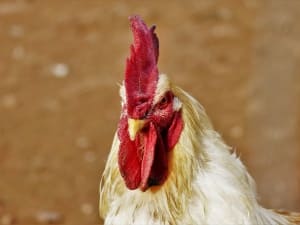
A wide variety of illnesses can affect your chickens, some illnesses are more serious than others.
If you realize that your bird’s appearance or behavior is changing in some way, if the bird has a lump in its throat, you’d be right to be concerned, this article looks into it
Table of Contents
Hard lump in chickens throat:
If your bird changes in behavior or appearance then there is something up with the bird, a change in appearance includes a hard lump developing in the bird’s throat. Here are possible reasons as to why this happens:
Normal full crop:
If you’ve only recently started inspecting the bird’s crop then what you may be seeing and feeling may be a normal full crop.
Chickens have an organ in the throat area called the crop. The crop is where food goes before it enters the rest of the bird’s digestive system to be digested.
A chicken’s crop will expand after the bird eats and may feel hard because it is full of food, this is normal.
The bird’s crop will go down and will go back to feeling flat once the food has passed through the bird’s crop into the rest of the bird’s digestive system.
What to do:
An enlarged and somewhat hard crop developing, just after the bird eats, is normal. It only becomes a problem if the bird’s crop doesn’t go down long after the bird has eaten.
Check that everything is normal by examining your bird’s crop just after it eats and then again long after it eats. Check the size of the bird’s crop during the evening and then check the size of the crop the next day before your bird eats breakfast.
If the lump goes down between evening and morning then you have nothing to worry about.
Impacted crop:
A bird’s crop enlarging because it is full of food is normal. Food should move into the rest of the bird’s digestive system after some time and the crop should reduce in size.
However, if the bird’s crop does not go down and empty long after the bird has eaten, then the bird is considered to have an impacted crop.
Crop impaction happens when indigestible materials, like straw, tough grass, fibrous foods, or long grasses are eaten by the bird, mix in with the feed in the bird’s crop, and then plug the bird’s crop.
A plugging of the crop can also happen if the bird eats a foreign object.
The food will stay in the bird’s crop, and keep compacting, if the bird continues to eat. The harder and denser the plug the more difficult it will be to get rid of.
What to do:
You can massage your bird’s impacted crop in an effort to get rid of it. Before massaging the crop you’d need to quarantine the bird and lubricate the inside of the bird’s neck.
Keep the bird quarantined for 24 hours and do not give any food to the bird at this time. You can however give the bird water to drink.
After the 24 hours are up slowly lubricate the bird’s throat using vegetable oil or olive oil, this oil will make its way into the bird’s crop.
The bird doesn’t need too much oil, pour only about a quarter teaspoon of oil down the bird’s throat.
Let the oil sit in the bird’s throat for 15 – 20 minutes to lubricate the throat and crop well enough. Once this time is up you can massage the crop in a gentle motion downwards to get the food down into the rest of the bird’s digestive system.
You may need to repeat this process twice or three times. The crop should look smaller and get less hard as you massage, a reduction in size means that the blockage is breaking up.
Continue to monitor the bird during and between massages.
If this massaging works, and the crop empties, then you can give your bird foods that are easy to digest.
Foods you can feed to birds during this time include minced vegetables, boiled and mashed up eggs, mashed fruit, plain yogurt, and fermented feed
Give the bird plenty of water before going back to the bird’s normal feed.
If the crop impaction can’t be cleared up in this way then the bird may need surgery to remove the impaction.
Crop impaction is a serious condition and doing surgery on the bird’s crop yourself can be dangerous. We don’t recommend that you do the surgery yourself, have a vet do this surgery.
If you enjoyed this article then you may also be interested in other chicken related articles. Here are some articles that you may be interested in: Chicken Cremation, Chicken Not Moving But Breathing, Wobbly Chicken, Chicken Having A Seizure, Sling For A Chicken With A Broken Leg

